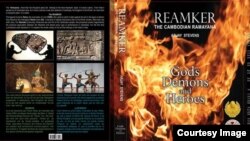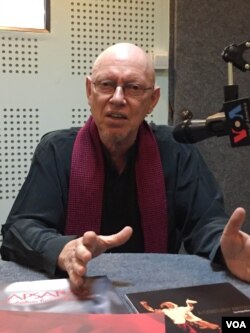German scientist-turned-photographer Arjay Stevens arrived in Cambodia in 1996 before the celebration of the annual Water Festival. Along the way from the airport, he came across Touk Ngor, a long colorful racing dragon boat which is used in the festival boat races. Stevens jumped out of the car to take a photo—that was his very first picture of Cambodia.
“That was how everything started,” he said, referring to his fascination with Cambodian culture.
Like any visitors touring the Royal Palace over twenty years ago, Steven set his eyes on the mural paintings engraved on the walls of the Silver Pagodas. He took interest in the Battle of Lanka and became interested in the story of Reamker.
“My fascination is persistent. When I first saw the painting at the Royal Palace, I did not know about the entire cultural empire behind it,” he said, “I had never seen anything like this before.”
Steven’s latest work illustrates a Cambodian epic poem based on the Ramayana, titled “Reamker The Cambodian Ramayana - God Demons and Heroes”. The 466-page photography book of mural paintings, temple carvings, and traditional masked dance performances took him 22 years to finish. The collection of photos and scripts retells the story of divinity and adventure by capturing the elements of this Indian-derived art form.
Known for his love for Southeast Asian arts, notably Khmer art, Stevens, 72, has captured thousands of photographs from all over the kingdom. His publications extensively covered a wide range of Cambodian arts from the Royal Ballet to traditional Khmer silk production. His work documents a country in transition from the nightmare of civil war into a “hopeful” democracy, Stevens writes in his autobiography.
For over a thousand years, Reamker has been depicted in all sorts of art forms in the creative works of Cambodia.
The legend of Reamker has provided moral values from which Cambodians can learn, said Chan Vanny, a professor from the Royal Academy of Cambodia. Aside from being a part of the official high-school curriculum, it highlights the important lessons that young Cambodians can learn from, Vanny added.
“There are many moral lessons to be learned in Reamker. One of them is teaching us about conflict solving and capacity building,” she said.
The fifteen-chapter photo book retells the story of Reamker in sequences. It discusses the variety, elegance, and visual representation of the art and the popular characters.
“In the small and big battle scenes, even if many appear excessively cruel, one can often smile about the magic and divine intervention in precarious situations. And this is not to mention the fantastic and erotic escapades of the monkey general Hanuman who is the darling of the audience in the dance performances,” wrote Stevens.
“My favorite character from the literature would be Lakshmana [the younger brother of Rama]. His relationship with Rama is very special,” said Stevens.
“They love each other very much, and it always surprises me in the story. As you can see in Lakhon Khol, the Sbek Thom dance, the shadow theater, they always seem so close. I like that,” he added.
The book shows a wide diversity of Cambodian visual arts and artifacts; Princess Norodom Bopha Devi, King Norodom Sihamoni’s half-sister, who is generally regarded as the icon of Cambodian royal ballet, wrote the foreword for the book.
“We are especially happy that major parts of the performances of the more than 1000-year old Royal Ballet and other dance troupes are another core chapter of this book,” she wrote.
“Steven’s excellent photographs show the beauty and supreme quality of the artist’s dance, choreography, and staging.”
Minister of Culture and Fine Arts Phoeurng Sackona also praised Stevens on his understanding and knowledge of Cambodian arts.








